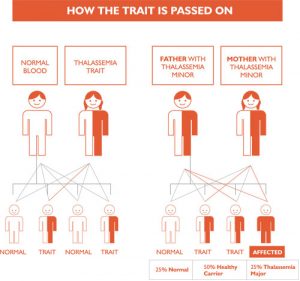Thalassemia is a genetic blood disorder where the body is not able to produce sufficient Hemoglobin which causes extreme form of Anemia. Hemoglobin carries oxygen to all parts of the body. Hence, when there is not enough hemoglobin in the body, there is shortage of oxygen supply to various organs which in turn affects efficient working of the organs. A child may suffer from Thalassemia if both the parents are carriers of Thalassemia.
A carrier of Thalassemia is also called Thalassemia Minor. A carrier will have no symptoms and will lead a normal life. Amitabh Bachchan is an example of a Thalassemia Minor. When two carriers get married, then there is a high risk of giving birth to a Thalassemia Major child. This is where the problem occurs.
Types of Thalassemia
There are two main types of Thalassemia: Alpha and Beta. Alpha Thalassemia Major is a serious disorder in which severe anemia begins even before birth and pregnant women are also at risk in such cases.
Beta Thalassemia Major is a situation where the symptoms appear in the first two years of life. These symptoms could be in the form of paleness of skin, poor appetite, fatigue and stunted growth. The treatment for this includes regular blood transfusions, removing excess iron from the body through iron chelation procedures and other medicines.
We would mainly be looking at Beta Thalassemia and the problems it creates for these children and their families.
What causes Thalassemia?
Thalassemia occurs when there’s an abnormality or mutation in one of the genes involved in
haemoglobin production. You inherit this genetic defect from your parents. If only one of your
parents is a carrier for thalassemia, you may develop a form of the disease known as thalassemia
minor. If this occurs, you probably won’t have symptoms, but you’ll be a carrier of the disease.

Image Source: http://www.chroniccare.org.lb
Symptoms
Following are the symptoms usually found in patients affected with thalassemia
- Fussiness
- .Infections.
- Bone deformations
- Paleness
- Iron overload
- Enlarged spleen
Cure
The cure of the disease depends on the type and the severity of the disease.
Bone marrow transplant: It may offer the possibility of a cure in young people who have a HLA-matched donor. Mortality from the procedure is about 3%. If the person does not have an HLA-matched compatible donor, another method called bone marrow transplantation (BMT) from haplo-identical mother to child (mismatched donor) may be used. In a study of 31 people, the thalassemia-free survival rate 70%, rejection 23%, and mortality 7%. The best results are with very young people.
Preventing Thalassemia
You can’t prevent thalassemia because they’re inherited (passed from parents to children through genes). However, prenatal tests can detect these blood disorders before birth. Family genetic studies may help find out whether people have missing or altered hemoglobin genes that causes thalassemia.
Treatments
Some of the treatments may include:
- Blood transfusions
- Iron chelation
- Spleenactomy
